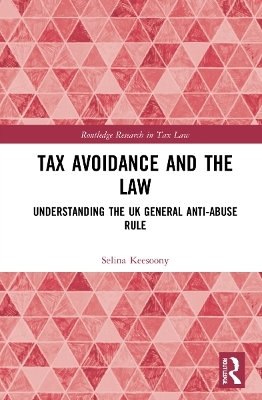
Tax Avoidance and the Law
Routledge (Verlag)
978-1-032-26488-2 (ISBN)
Tax Avoidance and the Law is a helpful guide for undergraduate and postgraduate students who want a thorough understanding of this dynamic area of law. The book is written in a way which is easy to follow and conveniently summarises complex case law on tax avoidance.
Tax Avoidance and the Law explores the evolution of the UK’s General Anti- Abuse Rule. It provides a useful comparison with other Western jurisdictions’ anti-avoidance legislation, including the United States of America, Australia, New Zealand, South Africa, Canada and the EU. The underlying theme of the book rests on the notion that the taxpayer’s subjective motives, intentions or purposes are irrelevant when assessing tax liability.
The book enables students to gain a good grasp of the fundamental issues in tax avoidance in a clear manner.
Selina Keesoony has lectured law at Brunel University London for over five years. She has also lectured law at SOAS, University of London. Selina completed her law degree at Brunel University. Following this, she pursued an LLM in international and comparative tax law at BPP Law School. While undertaking her master’s, she secured a studentship from Brunel University to undertake a PhD in tax law. Selina was awarded the Vice Chancellor’s Prize for Doctoral Research following the completion of her PhD. She has since completed the Legal Practice Course.
Acknowledgements
Introduction
Background
1 Defining motive, purpose and intention
1.1 Criminal law perspective
1.2 Psychological perspective
1.3 Philosophical perspective
1.4 Tax law perspective
1.4 (a) Trading
1.4 (b) Expenditure
1.4 (c) Dividend stripping
1.4 (d) Targeted anti-avoidance rules
1.5 Conclusions
2 A move towards motive, intention and purpose
Introduction
2.1 Tackling tax avoidance
2.2 The divide between supporters of Ramsay and Westminster
2.2 (a) Supporters of Ramsay
2.2 (b) Supporters of Westminster
2.3 Motive, intention and purpose considered across othermareas of tax law
2.3 (a) Trades, professions and vocations
2.3 (b) Expenditure
2.3 (c) Accountancy standards
2.4 Why the “motive approach” is considered
2.5 How motive, intention and purpose are considered
2.5 (a) The “substance over form” doctrine
2.5 (b) Purpose
2.5 (c) Commercial or business purpose
2.5 (d) The step transaction doctrine
2.5 (e) Motive or intention
2.6 Suitability of the motive approach in tax law
2.6 (a) Is the motive approach necessary?
2.6 (b) Restructuring transactions
2.6 (c) Inconsistencies
2.6 (d) Constitutional legitimacy of the motive approach
2.7 Conclusion
3 The GAAR provisions analysed
Introduction
3.1 The GAAR: An overview
3.2 The GAAR provisions
3.2 (a) Tax advantage
3.2 (b) Tax arrangement
3.2 (c) The main purpose test
3.2 (d) The double reasonableness test
3.2(d)(i) Reasonableness in tort and contract law
3.2(d)(ii) “Reasonableness” in public law
3.2(d)(iii) Reasonable man
3.2 (e) Abuse according to the GAAR
3.3 Abuse according to the GAAR guidance
3.4 What is not abusive
3.5 The scope of the GAAR
3.6 The Aaronson Report
3.7 Penalties
3.8 An EU-wide GAAR
3.9 Conclusion
4 General anti-avoidance legislation in other jurisdictions
Introduction
4.1 The United States’ Economic Substance Doctrine (“ESD”)
4.1 (a) Common law background
4.1 (b) The ESD provisions
4.1 (c) Case law post the American ESD
4.2 The Australian general anti-avoidance rule
4.2 (a) Scheme
4.2 (b) Tax benefit
4.2 (c) Purpose
4.3 Australian case law post the Australian general antiavoidance rule
4.4 The New Zealand general anti-avoidance rule
4.4 (a) Counteraction
4.4 (b) Case law post the New Zealand general antiavoidance rule
4.5 The South African general anti-avoidance rule
4.5 (a) Case law post the South African general antiavoidance rule
4.6 The Canadian general anti-avoidance rule
4.6 (a) Case law post the Canadian general anti-avoidance rule
4.7 Conclusion
5 Discretion under the UK GAAR
Introduction
5.1 The ambiguous GAAR
5.2 HMRC’s role
5.3 Judicial discretion
5.3 (a) Judicial law-making
5.3 (b) Interpretation
5.4 Morality
5.5 Conclusion
6 Criticisms of the GAAR
Introduction
6.1 The main purpose test
6.2 The double reasonableness test
6.3 The scope of the GAAR
6.4 HMRC GAAR guidance
6.5 The lack of a clearance system
6.6 The UK’s international competitiveness
6.7 Complexity
6.8 Uncertainty
6.9 Constitutional issues
6.10 Conclusion
7 Was the GAAR needed?
Introduction
7.1 Ramsay versus the GAAR
7.1 (a) The overall Ramsay approach
7.1 (b) The main features of the GAAR
7.1 (c) The Ramsay approach versus the GAAR
7.2 Contemporary tax avoidance before the GAAR
7.3 Tax avoidance since the GAAR
7.4 The GAAR as a deterrent
7.5 Conclusion
8 Conclusion and recommendations for reform
Recommendations for reform
Index
| Erscheinungsdatum | 15.06.2022 |
|---|---|
| Reihe/Serie | Routledge Research in Tax Law |
| Verlagsort | London |
| Sprache | englisch |
| Maße | 156 x 234 mm |
| Gewicht | 453 g |
| Themenwelt | Recht / Steuern ► Allgemeines / Lexika |
| Recht / Steuern ► EU / Internationales Recht | |
| Recht / Steuern ► Strafrecht | |
| Wirtschaft ► Betriebswirtschaft / Management ► Unternehmensführung / Management | |
| Wirtschaft ► Volkswirtschaftslehre | |
| ISBN-10 | 1-032-26488-8 / 1032264888 |
| ISBN-13 | 978-1-032-26488-2 / 9781032264882 |
| Zustand | Neuware |
| Informationen gemäß Produktsicherheitsverordnung (GPSR) | |
| Haben Sie eine Frage zum Produkt? |
aus dem Bereich


